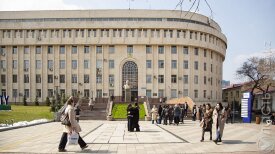During Kazakhstan’s Bloody January two years ago, security forces shot against each other and this, alongside gaps in the judicial system in the investigation and prosecution of the events, tells the story that they were only ready to protect their own political regimes, not the population.
Lieutenant colonel Galymzhan Sadvakasov detailed the shortcomings of law enforcement officials during an interview with Radio Azattyq last week. Sadvakasov, a former academy trainer at the Border Academy of the National Security Committee (KNB), said that these shortcomings were caused by an ongoing bureaucratization of the armed forces.
During Qandy Qantar, servicemen were unprepared and carried out uncoordinated work, according to Sadvakasov. They had only been prepared to march on military parades and fulfill orders from above.
Their lack of preparation, Sadvakasov argued, resulted in random clashes between various departments during the emergency of Bloody January.
Policemen and officers of the KNB had a shootout in Almaty while trying to protect the TV tower. During his trial, Yerbol Zhumanov, accused of killing a KNB officer, said that the latter was killed by friendly fire during clashes between the military and the KNB.
In light of these facts, the authorities’ version of Qandy Qantar as a clash between security forces and organized militants represents a distortion of reality.
This version, stemming from the state propaganda system, contends that in January 2022 the political regime of “old Kazakhstan” sought to overthrow the representatives of “new Kazakhstan” that had garnered power since 2019.
In line with this goal, the narration goes, subversive elements that had infiltrated within the security forces acted in concert with the militants. And together they attempted a coup, to dismember state institutions and, taking advantage of the political vacuum, to seize power.
On the first anniversary of Qandy Qantar, the prosecutor general presented the details of this version of the unrest to the representatives in Parliament. This year, on the second anniversary, a number of “content makers” - from bloggers to political scientists - were used to demonstrate this version as the indisputable truth.
But the lieutenant colonel's interview, combined with the propaganda line, leads us to another conclusion. The security forces could engage in battle with each other not only because of administrative chaos, but also because they helped one of the political regimes gain the upper hand over the other.
In an effort to prevent this power vacuum, security forces clashed internally.
“The only source of political power is the people,” says the Constitution. Paradoxically, however, the security forces ensured the protection of either of the political factions instead. In this struggle, they turned a blind eye towards innocent civilians that could be in their way.
Political representatives have repeatedly failed to pass legislation in the interests of the Kazakhstani people, laws that would regulate the security forces, for example.
In his interview, Sadvakasov confirmed that the security forces are essentially an institution for the upward social mobility of some of their recruits. In exchange for loyalty towards the ruling elite, they get a secure and hassle-free job.
Their only task is to keep the ruling elite - no matter whether incumbent or striving for control - in power at any cost. The protection of society is not a priority.
Поддержите журналистику, которой доверяют.








